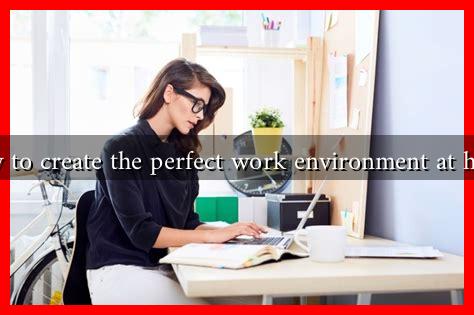-
Table of Contents
How to Create the Perfect Work Environment at Home
In recent years, remote work has transitioned from a temporary solution to a long-term arrangement for many professionals. As a result, creating an effective work environment at home has become essential for productivity, mental well-being, and work-life balance. This article explores key strategies to design a home workspace that fosters focus, creativity, and comfort.
Understanding the Importance of a Dedicated Workspace
Establishing a dedicated workspace is crucial for separating professional responsibilities from personal life. According to a study by Stanford University, remote workers can be more productive than their in-office counterparts, but only if they have a designated area for work. A well-defined workspace can help minimize distractions and signal to your brain that it’s time to focus.
Choosing the Right Location
The location of your home office plays a significant role in your productivity. Here are some factors to consider:
- Natural Light: Choose a space with ample natural light to boost mood and energy levels. Studies show that exposure to natural light can improve alertness and reduce eye strain.
- Quiet Environment: Select a location away from high-traffic areas in your home to minimize noise and interruptions.
- Comfortable Temperature: Ensure the room is well-ventilated and maintains a comfortable temperature to enhance focus.
Investing in Ergonomic Furniture
Comfort is key when working from home. Investing in ergonomic furniture can prevent physical strain and enhance productivity. Consider the following:
- Ergonomic Chair: A chair that supports your back and promotes good posture can reduce discomfort during long working hours.
- Adjustable Desk: A sit-stand desk allows you to alternate between sitting and standing, which can improve circulation and reduce fatigue.
- Monitor Placement: Position your monitor at eye level to prevent neck strain and ensure a comfortable viewing angle.
Creating an Inspiring Atmosphere
Your workspace should inspire creativity and motivation. Here are some tips to enhance the ambiance:
- Personal Touches: Decorate your workspace with personal items, such as photos, artwork, or plants, to create a welcoming environment.
- Color Psychology: Use colors that promote productivity. For example, blue is known to enhance focus, while green can reduce stress.
- Organized Space: Keep your workspace tidy and organized. A clutter-free environment can lead to a clearer mind and improved efficiency.
Establishing a Routine
Having a structured routine can significantly impact your productivity. Here are some strategies to consider:
- Set Working Hours: Define specific working hours to create boundaries between work and personal time.
- Regular Breaks: Incorporate short breaks to recharge. The Pomodoro Technique, which involves working for 25 minutes followed by a 5-minute break, can be effective.
- Daily Goals: Start each day by setting clear, achievable goals to maintain focus and motivation.
Leveraging Technology
Utilizing technology can enhance your work-from-home experience. Consider these tools:
- Project Management Software: Tools like Trello or Asana can help you organize tasks and collaborate with team members.
- Communication Platforms: Use platforms like Slack or Microsoft Teams to stay connected with colleagues.
- Time Management Apps: Apps like RescueTime can help you track productivity and identify areas for improvement.
Conclusion
Creating the perfect work environment at home is a multifaceted process that involves careful consideration of location, furniture, atmosphere, routine, and technology. By investing time and resources into designing a workspace that meets your needs, you can enhance your productivity, creativity, and overall well-being. Remember, a well-structured home office is not just about aesthetics; it’s about creating a space that supports your professional goals while maintaining a healthy work-life balance.
For more tips on remote work and productivity, check out resources from Forbes.

